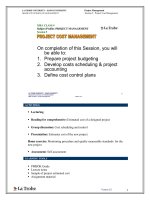Lecture no53 benefit cost ratio
Bạn đang xem bản rút gọn của tài liệu. Xem và tải ngay bản đầy đủ của tài liệu tại đây (483.17 KB, 17 trang )
Benefit-Cost Ratio
Lecture No. 53
Chapter 16
Contemporary Engineering Economics
Copyright © 2016
th
Contemporary Engineering Economics, 6 edition
Park
Copyright © 2016 by Pearson Education, Inc.
All Rights Reserved
Benefit-Cost Analysis
•
•
The benefit-cost analysis is commonly used to evaluate public projects.
Benefits of a nonmonetary nature need to be quantified in dollar terms as much as possible
and factored into the analysis.
•
A broad range of project users distinct from the sponsor can and should be considered—
benefits and disbenefits to all these users can and should be taken into account.
th
Contemporary Engineering Economics, 6 edition
Park
Copyright © 2016 by Pearson Education, Inc.
All Rights Reserved
Framework of Benefit-Cost Analysis
Step 1: Identifying all the users and
sponsors of the project.
Step 2: Identifying all the benefits and
disbenefits of the project.
Step 3: Quantifying all benefits and
disbenefits in dollars or some other unit
of measure.
Step 4: Selecting an appropriate interest
rate at which to discount benefits and
costs in future to a present value.
th
Contemporary Engineering Economics, 6 edition
Park
Copyright © 2016 by Pearson Education, Inc.
All Rights Reserved
Benefit-Cost Ratio Criterion
Equivalent Users' Net Benefits
Benefit-Cost Ratio =
Equivalent Sponsor's Net Cost
If this BC ratio exceeds 1, the project can be justified.
th
Contemporary Engineering Economics, 6 edition
Park
Copyright © 2016 by Pearson Education, Inc.
All Rights Reserved
Definition of Benefit-Cost Ratio
N
B = ∑ bn (1 + i)− n
n=0
N
C = ∑ cn (1 + i)− n
n=0
bn=Benefit at the end of period n, bn ≥ 0
cn= Expense at the end of period n, cn ≥ 0
An= bn − cn
N = Project life
i = Sponsor’s interest rate (discount rate)
th
Contemporary Engineering Economics, 6 edition
Park
Copyright © 2016 by Pearson Education, Inc.
All Rights Reserved
Breakdown of the Sponsor’s Cost
K
I = ∑ cn (1 + i)− n
n=0
C'=
N
∑
n = K +1
cn (1 + i)− n
Equivalent capital investment
at n = 0
Equivalent O&M costs
at n = 0
B
B
BC (i) = =
, I +C'> 0
C I +C'
th
Contemporary Engineering Economics, 6 edition
Park
Copyright © 2016 by Pearson Education, Inc.
All Rights Reserved
Example 16.1: Benefit-Cost Ratio
Indian River Lagoon South Project: To
reverse the damaging effects of pollution
and unnaturally large freshwater
discharges into these ecologically vital
water bodies.
Price tag of $1.2B
Annual benefits of $159M along with
other environmental benefits
Is it worth undertaking?
th
Contemporary Engineering Economics, 6 edition
Park
Copyright © 2016 by Pearson Education, Inc.
All Rights Reserved
Description of Financial Data
Given: Financial data for IRL-South Project
o
Estimated construction cost =
$1,207,288,000
o
Annual recurring O&M, repair costs =
$6,144,700
o
o
o
Estimated annual benefits = $159,000,000
Discount rate = 5 5/8%
Project period = 39 years
Find: B/C ratio
th
Contemporary Engineering Economics, 6 edition
Park
Copyright © 2016 by Pearson Education, Inc.
All Rights Reserved
Benefit-Cost Ratio Calculation
th
Contemporary Engineering Economics, 6 edition
Park
Copyright © 2016 by Pearson Education, Inc.
All Rights Reserved
Incremental Analysis Based on BC(i)
If BC(i)k-j > 1, select alternative j which has the
smaller cost.
If ΔI + ΔC’ = 0, we cannot use the benefit-cost ratio.
When this happens, just select the project with the
largest B value.
In situations where public projects with unequal
service lives are to be compared, compute all
component values (B, I, and C’) on an annual basis.
th
Contemporary Engineering Economics, 6 edition
Park
∆B = Bk − Bj
∆I = Ik − I J
∆C ' = C 'k − C ' j
∆B
BC (i)k − j =
∆I + ∆C '
Copyright © 2016 by Pearson Education, Inc.
All Rights Reserved
Example 16.2: Incremental Benefit-Cost Ratios: Four Alternatives
Given: I, B, C’, and i = 5%, N = 30 years
Find: Which design option?
th
Contemporary Engineering Economics, 6 edition
Park
Copyright © 2016 by Pearson Education, Inc.
All Rights Reserved
Step 1: Calculate BC (5%) for Each Alternative
th
Contemporary Engineering Economics, 6 edition
Park
Copyright © 2016 by Pearson Education, Inc.
All Rights Reserved
Step 2: Incremental Analyses
th
Contemporary Engineering Economics, 6 edition
Park
•
A1 versus A2
•
A3 versus A2
•
A4 versus A3
Copyright © 2016 by Pearson Education, Inc.
All Rights Reserved
Profitability Index
•
Definition: Net benefits expressed per dollar invested.
•
Decision Rule
PI(i ) > 1, accept
PI(i ) <1, reject.
th
Contemporary Engineering Economics, 6 edition
Park
Copyright © 2016 by Pearson Education, Inc.
All Rights Reserved
Relationship Between B/C Ratio, NPW, and PI
B
>1
I +C'
B > (I + C’)
PI(i ) =
PW(i ) B − C '
=
>1
I
I
B − (I+ C’) > 0
PW(i) = B − C > 0
th
Contemporary Engineering Economics, 6 edition
Park
Copyright © 2016 by Pearson Education, Inc.
All Rights Reserved
Summary
o
o
A benefit-cost analysis is commonly used to evaluate public projects.
Difficulties involved in public project analysis include the following:
1)
2)
3)
4)
Identifying all the users who can benefit from the project.
Identifying all the benefits and disbenefits of the project.
Quantifying all benefits and disbenefits in dollars or some other unit of measure.
Selecting an appropriate interest rate at which to discount benefits and costs to a present value.
th
Contemporary Engineering Economics, 6 edition
Park
Copyright © 2016 by Pearson Education, Inc.
All Rights Reserved
o
o
The B/C ratio is defined as:
B
B
BC(i ) = =
,I + C ' > 0
Cis acceptable.
I +C'
The decision rule: if BC(i) > 1, the project
The profitability index (PI) is defined as
The PI expresses the net benefit expected per dollar invested. The same decision rule applies as for
the B/C ratio.
B − C ' B'
PI(i ) =
= ,I > 0
I
I'
th
Contemporary Engineering Economics, 6 edition
Park
Copyright © 2016 by Pearson Education, Inc.
All Rights Reserved









